(This is our fifth post about the films of diplomat John Van Antwerp MacMurray. See the first post for more background.)
When watching MacMurray’s peaceful films of China, it is easy to forget that the country was torn by civil war for most of the time he served as minister. The films labeled “Peking Misc(ellaneous) I-II,” serve as a reminder. The first film opens with drills of the U.S. Marines of the Legation Guard, who protected the legation and, in emergencies, American citizens. In addition, the second film contains elaborate, rare footage of Nationalist troops, which may have been shot during the “capture” of Peking in June 1928 that ended the Nationalists’ Northern Campaign and left Chiang Kai-shek and his party in control of the country.
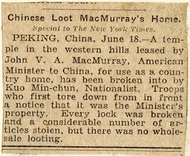
Above: Newspaper clipping of June 18, 1928, about a break-in by Nationalist soldiers of Ta Pei Ssu, a temple leased by MacMurray (box 104).
According to a newspaper clipping in MacMurray’s papers, Nationalist soldiers broke into the ‘Ta Pa Ssu’ temple in the Western Hills, which was leased by the MacMurray family. (For more on temple renting, see our previous entry.) Fear of looting and violence against foreigners, as had occurred during the Nationalist capture of Nanking in March 1927, was widespread. These fears proved unfounded, however, as can be read in My Life in China, the memoirs of Hallett Abend, a reporter for the New York Times. After negotiations with the foreign legations, the generals of the armies that surrounded the city agreed that Chang Tso-lin, the Manchurian warlord in control of Peking, would be allowed to leave the city, while his best-disciplined troops stayed behind to retain order. When General Yen Hsi-shan’s troops entered the city through the South Gate, Chang’s troops would exit through the Northeast gate. Does MacMurray’s footage capture these events?
The first film opens with a visit of presumably Admiral Clarence Williams, commander in chief of the US Asiatic Fleet (1:09), and a parade by the Marines of the Legation Guard. (The naval officers with bicorn hats (0:53) are not identified). The footage continues with a long series of drills, in which the Marines are simulating their defense of the Legation Quarter: first, the gates are closed and mounted Marines are sent out to “rescue” Americans (1:39), while heavy machine guns and supplies are retrieved from the armory with two wheel carts (2:01). This is followed by artillery drill practice from the Tartar Wall (2:30). The remainder of the film shows various Peking sites, including Beihai Park, and footage of Peking in snow. In addition, the film contains street and market scenes and shots of musicians and performers.
The second film continues with local scenes of Peking and its surroundings, including a funeral procession (0:12), street and market scenes, ice skating (2:21), and the selling and burning of incense at a temple (4:34). The footage that may capture the entry of Nationalist soldiers in Peking starts at 7:14.
MacMurray filmed an encounter with an unidentified military officer (7:58), groups of vehicles and packed camels, and armed and unarmed troops (8:38, 8:43, 8:54, 9:13, 9:19, 9:35), wearing different armbands and on two occasions carrying different flags (8:38 and 8:54). Filming the groups from different locations, MacMurray appears to have sought a variety of military and uniformed groups, alternating with shots of onlookers and guards. Of particular interest are the men with straw hats wearing armbands with Guomindang stars (9:35). The film ends with footage of a soldier raising the Nationalist flag (10:15), and a scene at a train station, with soldiers leaving on an open car (10:22). The brief footage following, shot aboard a boat, does not seem to be related.
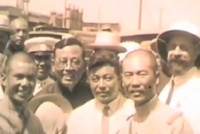 The footage leaves many questions. Did MacMurray film this on June 8 1928, the day that the Nationalist troops entered the city, or was it spread over a few days? Who was the military officer who gets so much attention (the fourth from the left in the picture here)? What do the two flags at 8:38 and 8:54 indicate, and what is the meaning of the different armbands, which were often used to differentiate between forces and units (8:38, 9:19, 9:36)? Ultimately, who are the troops in the end, leaving by train? When the Manchurian troops, who had been promised safe conduct, evacuated the city, they were surrounded and disarmed by the soldiers of a subordinate general, Han Fu-chu. The incident required the intervention of the diplomatic corps. Is any of this footage related to that? If you are able to shed any light on the films, we would love hear from you!
The footage leaves many questions. Did MacMurray film this on June 8 1928, the day that the Nationalist troops entered the city, or was it spread over a few days? Who was the military officer who gets so much attention (the fourth from the left in the picture here)? What do the two flags at 8:38 and 8:54 indicate, and what is the meaning of the different armbands, which were often used to differentiate between forces and units (8:38, 9:19, 9:36)? Ultimately, who are the troops in the end, leaving by train? When the Manchurian troops, who had been promised safe conduct, evacuated the city, they were surrounded and disarmed by the soldiers of a subordinate general, Han Fu-chu. The incident required the intervention of the diplomatic corps. Is any of this footage related to that? If you are able to shed any light on the films, we would love hear from you!
Our thanks to Dirk Haig for his explanation of the Marine drills, Shuwen Cao for her identifications of local scenes, and Edward McCord for his information about Chinese uniforms, armbands, and flags.



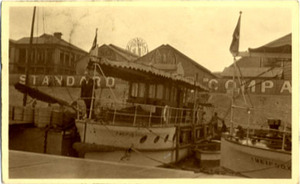
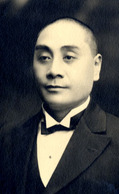
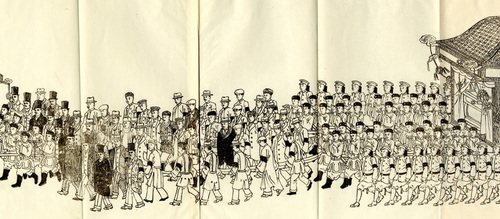
 MacMurray, whose caricature is shown on the left, sent a copy to his chief Stanley Hornbeck, with the comment that Gallostra had a “genius for caricature and an irrepressible spirit of mockery” (19 July, 1929). In the film featured here, Gallostra, who is impersonating different characters, seems to be mimicking the prescribed behavior of the diplomatic representatives when paying their last respects to Sun Yat-sen. During a ceremony on May 31, prior to the reinterment, each minister placed a wreath at the foot of the dais at the headquarters of the Nationalist Party, where the embalmed body lay in state. The three bows while moving forward and backward can be found in descriptions of the ceremony. (Our thanks to Shuwen Cao, East Asian Library, Princeton University for clarifying this).
MacMurray, whose caricature is shown on the left, sent a copy to his chief Stanley Hornbeck, with the comment that Gallostra had a “genius for caricature and an irrepressible spirit of mockery” (19 July, 1929). In the film featured here, Gallostra, who is impersonating different characters, seems to be mimicking the prescribed behavior of the diplomatic representatives when paying their last respects to Sun Yat-sen. During a ceremony on May 31, prior to the reinterment, each minister placed a wreath at the foot of the dais at the headquarters of the Nationalist Party, where the embalmed body lay in state. The three bows while moving forward and backward can be found in descriptions of the ceremony. (Our thanks to Shuwen Cao, East Asian Library, Princeton University for clarifying this).